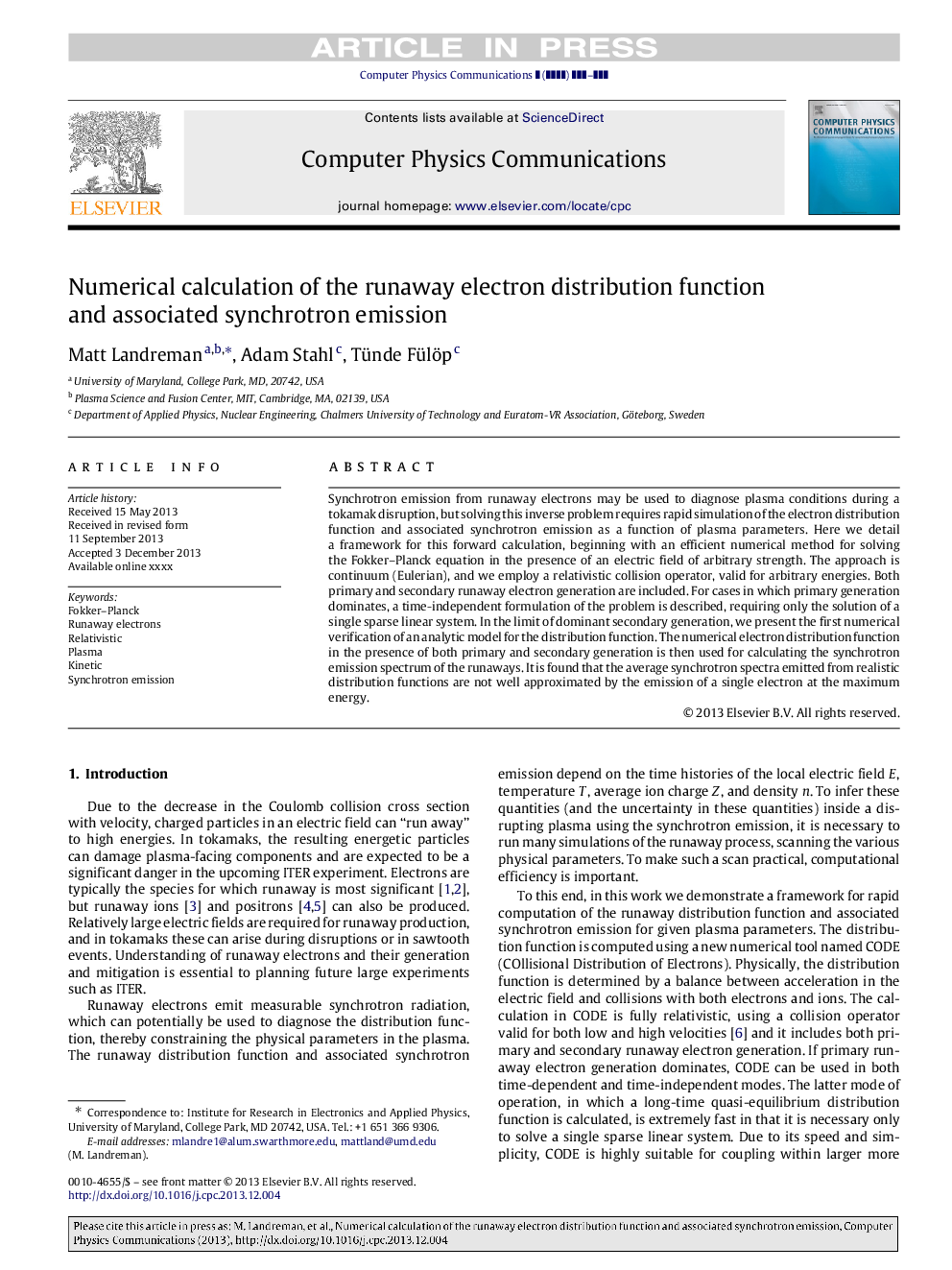| کد مقاله | کد نشریه | سال انتشار | مقاله انگلیسی | نسخه تمام متن |
|---|---|---|---|---|
| 10349755 | 863707 | 2014 | 9 صفحه PDF | دانلود رایگان |
عنوان انگلیسی مقاله ISI
Numerical calculation of the runaway electron distribution function and associated synchrotron emission
ترجمه فارسی عنوان
محاسبه عددی تابع توزیع الکترون فرار و انتشار سینکروترون همراه است
دانلود مقاله + سفارش ترجمه
دانلود مقاله ISI انگلیسی
رایگان برای ایرانیان
کلمات کلیدی
فوککر پلانک، الکترون های فراری، نسبیتی، پلاسما، جنبشی، انتشار سینکروترون،
ترجمه چکیده
انتشار سینکروترون از الکترون های فرار می تواند برای تشخیص شرایط پلاسما در یک اختلال توکاماک استفاده شود، اما حل این مشکل معکوس نیازمند شبیه سازی سریع عملکرد توزیع الکترون ها و انتشار انتشار همزمان آن به عنوان عملکرد پارامترهای پلاسما است. در اینجا چارچوبی برای این محاسبات پیشنهادی را با یک روش عددی کارآمد برای حل معادله فوکر-پلانک در حضور میدان الکتریکی قدرت دلخواه آغاز میکنیم. این رویکرد پیوسته (یولرین) است و ما از یک اپراتور برخورد نسبیتی استفاده میکنیم که برای انرژیهای دلخواه معتبر است. هر دو نسل اول و دوم فرکانسی الکترون شامل می شوند. برای مواردی که در آن نسل اول غالب می شود، فرموله سازی مستقل زمانی از مشکل توصیف می شود، و فقط نیاز به حل یک سیستم خطی منفرد است. در محدودۀ نسل دوم غالب، ما اولین تایید عددی یک مدل تحلیلی برای عملکرد توزیع را ارائه می دهیم. سپس توابع توزیع الکترون های عددی در حضور هر دو نوع اولیه و ثانویه برای محاسبه طیف انتشار سیگلوسترون فراری استفاده می شود. یافته شده است که میانگین طیف های سینکروترون که از توابع توزیع واقع بینانه پخش می شود، به وضوح با انتشار الکترون تک در حداکثر انرژی تقریب نمی شود.
موضوعات مرتبط
مهندسی و علوم پایه
شیمی
شیمی تئوریک و عملی
چکیده انگلیسی
Synchrotron emission from runaway electrons may be used to diagnose plasma conditions during a tokamak disruption, but solving this inverse problem requires rapid simulation of the electron distribution function and associated synchrotron emission as a function of plasma parameters. Here we detail a framework for this forward calculation, beginning with an efficient numerical method for solving the Fokker-Planck equation in the presence of an electric field of arbitrary strength. The approach is continuum (Eulerian), and we employ a relativistic collision operator, valid for arbitrary energies. Both primary and secondary runaway electron generation are included. For cases in which primary generation dominates, a time-independent formulation of the problem is described, requiring only the solution of a single sparse linear system. In the limit of dominant secondary generation, we present the first numerical verification of an analytic model for the distribution function. The numerical electron distribution function in the presence of both primary and secondary generation is then used for calculating the synchrotron emission spectrum of the runaways. It is found that the average synchrotron spectra emitted from realistic distribution functions are not well approximated by the emission of a single electron at the maximum energy.
ناشر
Database: Elsevier - ScienceDirect (ساینس دایرکت)
Journal: Computer Physics Communications - Volume 185, Issue 3, March 2014, Pages 847-855
Journal: Computer Physics Communications - Volume 185, Issue 3, March 2014, Pages 847-855
نویسندگان
Matt Landreman, Adam Stahl, Tünde Fülöp,
